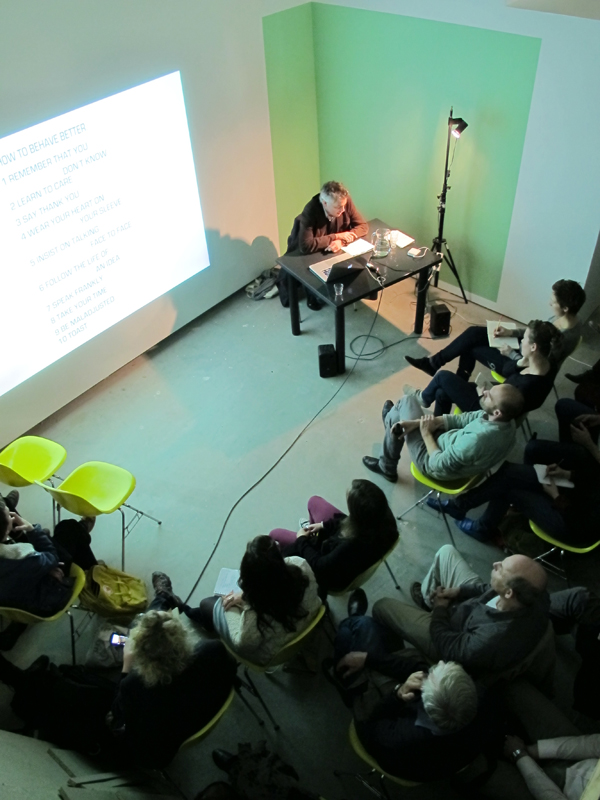Vandaag kwam ik al grasduinend terecht op de website van The Artist's Institute en ik wilde eventuele lezers het mooie taalgebruik waarmee het werk van Jimmie Durham wordt beschreven niet onthouden. Er wordt namelijk - in plaats van het gebruikelijke International Art English geschreven in een uiterst speelse, verhalende en heldere taal.
Today, we should be thinking about the artist Jimmie Durham (b. 1940, Washington, Arkansas).
Western civilization, over the past few millennia, has been quite busy inventing ways to organize the world. Big and small, techniques have varied: there has been religion, of course, but also notions like nation-states, architecture, written language, money, or property. They are some of the ways humanity has felt it can achieve dominion over the unruliness of the world and make it that much more manageable for us to live there.
It doesn’t have to be this way, it isn’t this way for everyone, and it certainly isn’t this way for the artist Jimmie Durham.
Durham likes to go places. He was in Arkansas in the 1950s, Texas in the 1960s, Geneva, Switzerland in the 1970s, devoted himself to art in the 1980s in New York, moved to Mexico in 1987, and, since 1994, has been living in Eurasia (what is Europe?). Durham makes sculptures, drawings, photographs, performances, and videos. He writes a lot of poetry and listens to a lot of music. He loves good food, good wine, good stories, good stones, and good people.
Over the past few hundred years, European settlers in North America have ruthlessly exterminated the vast majority of the continent’s native population and its heritage. Durham was actively involved with the American Indian Movement, as the group’s representative at the U.N., and although he instigated important conferences and published many texts, the movement was too fractured to be effective. Turning towards art, he began showing artifacts from thousands of years in the future, when white people will only be a myth.
Durham’s sculptures pointed to some of the weapons Americans used as they carried out the genocide: inventions like linearity, logic, belief, and binary constructs. Outside of that tradition, however, divisions such as nature/culture, civilized/primitive, real/fake, old/new, and mine/yours simply don’t make any sense.
Modernity, they say, was about the death of God, the self-conscious agency of man, and culture learning how to control nature. But then again, the philosopher Bruno Latour says that we have never been modern, and that we can’t truly distinguish ourselves from the animals, rocks, land, and ecosystems we live with and within.Control, in fact, is only a nicer way to describe human disrespect.
Durham wants no control or authority over the objects he makes. When a piece of wood manages to escape from one of his sculptures, he told me late one summer night, it has done its job. After all, inanimate objects have their own agency and a stone should express the stone point of view. Durham doesn’t want to speak through his objects, but wants them to talk on their own, with him, and with an audience. He asks only that all of us listen with care, listen with respect, and listen with imagination.
To understand, he says, is simply a Western consumer product, available for the price of a magazine.
For Durham, architecture is nothing but organized stone, and language, when it is written down, prevents us from thinking for ourselves.
Should a stone get distracted and prefer to deviate, why not listen to it? Did you forget that history is nothing but a collection of stories dancing together?
Unfortunately, if you tell a story long enough, and write it down in enough places, it becomes true. The history of America, for one, began thousands of years before its official story says it did. In quiet protest, Durham keeps telling jokes that only Indians can get, exposing the Western perspective as being written in a language that is incapable of translating concepts alien to it.
And did you know that there are several languages in Mexico in which complete conversations can be whistled?
Jimmie Durham makes art that sets an object in motion, freeing it from language, metaphor, linear narrative, and explanation. One picture is actually worth no amount of words, and God isn't in the details, but in the detours and the interruptions.
One of the artist's exhibition titles says it best: art is obviously not a matter of life and death - it's a matter of life, death, and singing.
The third season at The Artist's Institute, with Jimmie Durham, runs from August 24, 2011 to January 15, 2012.
Bron: http://www.theartistsinstitute.org/archive/main.html?id=41


